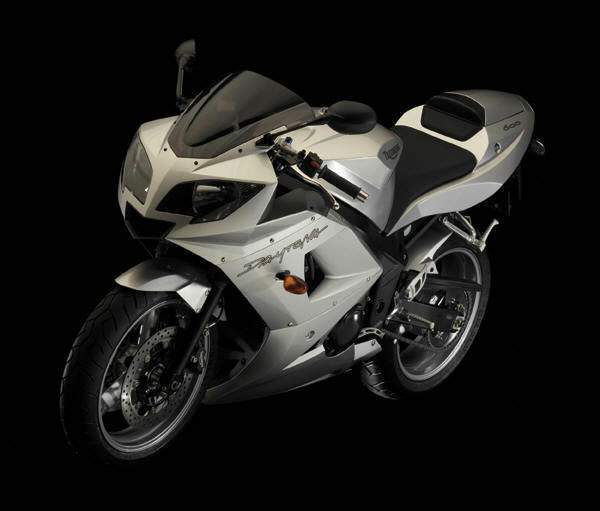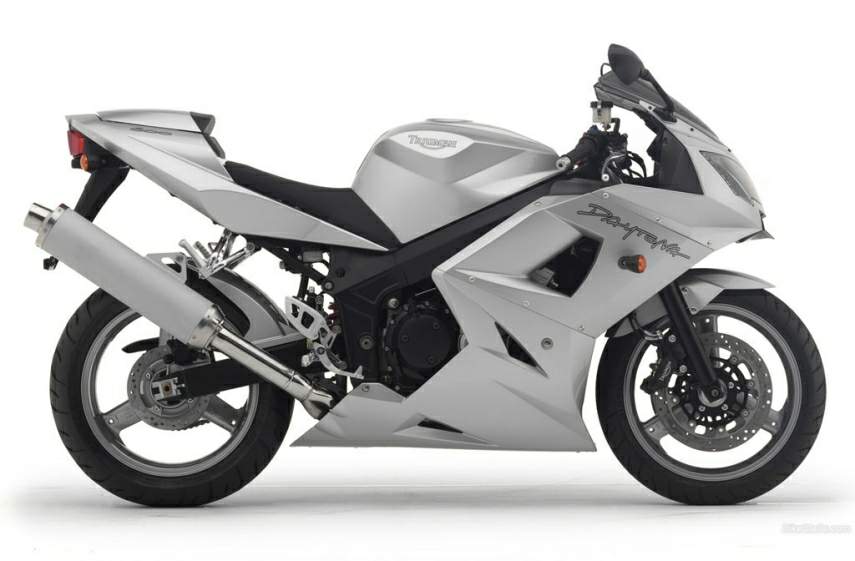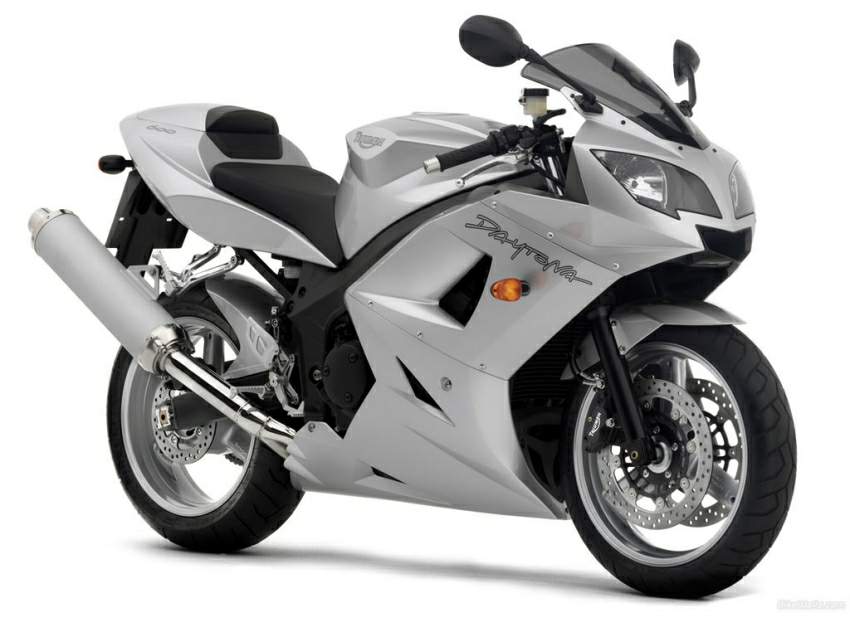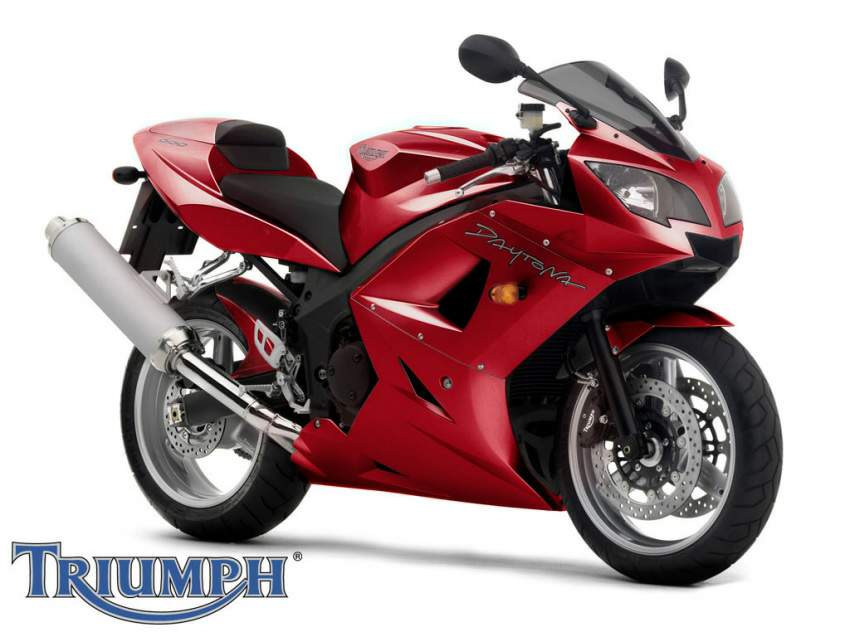
|
|
|
|
|
|
Classic Bikes
Custom Bikes
Individual
Racing Bikes AJP
AJS
Aprilia
Ariel
Avinton / Wakan
Bajaj
Benelli
Beta
Bimota
BMW
Brough Superior
BRP Cam-Am
BSA
Buell / EBR
Bultaco
Cagiva
Campagna
CCM
CF Moto
Combat Motors
Derbi
Deus
Ducati
Excelsior
GASGAS
Ghezzi Brian
Gilera
GIMA
Harley Davidson
Hero
Highland
Honda
Horex
Husaberg
Husqvarna
Hyosung
Indian
Jawa
Kawasaki
KTM
KYMCO
Laverda
Lazareth
Magni
Maico
Mash
Matchless
Mondial
Moto Guzzi
Moto Morini
MV Agusta
MZ / MuZ
NCR
Norton
NSU
Paton
Peugeot
Piaggio
Revival Cycles
Roland Sands
Royal Enfield
Sachs
Sherco
Sunbeam
Suzuki
SWM
SYM
Triumph
TVS
Ural
Velocette
Vespa
Victory
Vincent
VOR
Voxan
Vyrus
Walt Siegl
Walz
Wrenchmonkees
Wunderlich
XTR / Radical
Yamaha
Zero
Video
Technical
Complete Manufacturer List
|
Triumph Daytona 600
|
| . |
|
Make Model |
Triumph Daytona 600 |
|
Year |
2003 |
|
Engine |
Four stroke, transverse four cylinder. DOHC, 4 valves per cylinder. |
|
Capacity |
599 cc / 36.6 cu in |
| Bore x Stroke | 68 x 41.3 mm |
| Cooling System | Liquid cooled |
| Compression Ratio | 12.5:1 |
| Lubrication | Wet sump |
| Engine Oil | Synthetic, 15W/50 |
|
Induction |
Twin-butterfly, multipoint sequential electronic fuel injection |
|
Ignition |
Digital - inductive type - via electronic management system |
| Spark Plug | NGK, CR9EK |
| Starting | Electric |
|
Max Power |
81.6 kW / 112 hp @ 12750 rpm |
|
Max Torque |
68 Nm / 6.93 kg-m / 50.2 lb-ft @ 11000 rpm |
| Clutch | Wet, multi-plate |
|
Transmission |
6 Speed |
| Final Drive | X ring chain |
| Frame | Aluminium beam perimeter, swingarm twin-sided, aluminium alloy |
|
Front Suspension |
43mm Cartridge forks, adjustable preload, compression and rebound damping |
| Front Wheel Travel | 120 mm / 4.7 in |
|
Rear Suspension |
Monoshock with adjustable preload, compression and rebound damping |
| Rear Wheel Travel | 120 mm / 4.7 in |
|
Front Brakes |
2 x 308 mm Discs, 4 piston calipers |
|
Rear Brakes |
Single 220 mm disc, 1 piston caliper |
|
Front Tyre |
120/70 ZR17 |
|
Rear Tyre |
180/55 ZR17 |
| Wheel Front | 3-spoke, 17 x 3.5in |
| Wheel Rear | 3-spoke, 17 x 5.5in |
| Rake | 24.6º |
| Trail | 89.1 mm / 3.5 in |
|
Dimensions |
Length 2050 mm / 80.7 in Width 660 mm / 26.0 in Height 1135 mm / 44. 7in |
| Seat Height | 815 mm / 32.1in |
| Wheelbase | 1390 mm / 54.7in |
|
Dry Weight |
165 kg / 363 lbs |
|
Fuel Capacity |
18 Litres / 4.7 US gal / 4.0 Imp gal |
| Reviews | Motorcycle-USA / Motorbikes Today |

Launched in April 2003 as an early release 2004 model, the existing Daytona 600 colours are joined by a vivid third option - Tornado Red.
The Daytona name is the stuff of legends for Triumph Motorcycles and not used lightly. The subtle, discreet logo on the Daytona 600's purposeful bodywork reinforces just what this new bike is about; power, poise and complete control. Fully aware of its lineage Triumph has honed the Daytona 600 into a package that provides complete rider involvement. Also, impressed with the need for individuality, the Daytona 600 is a machine that not only looks very different but is also built with a level of care and attention to detail that ensures a great deal of owner satisfaction.

The heart and lungs of any motorcycle is its engine and the Daytona's 599cc liquid-cooled four-cylinder motor pumps out plenty of power. The target output - 112PS (110bhp) - was reached but not at the expense of driveability and, by utilising Keihin twin-butterfly EFI throttle bodies and 32 bit processor, throttle response is razor sharp and precise. The lightweight exhaust system is made from 1.2mm thin wall steel tube and is of a 4-2-1-2-1 design with header lengths tuned to suit the intake system, head porting and combustion chamber shape. Peak power arrives at 12,750rpm. Peak torque, 68Nm (50.5ft.lbf), is delivered at 11,000 rpm.
The aluminium twin spar frame uses a three-cell construction and is both incredibly light and strong. Rake and trail are a lightning-sharp 24.6°/89.1mm and the wheelbase a diminutive 1390mm (54.7in). The front 43mm cartridge forks use single-rate springs. All fork internals - rods, cartridges and fixings - are made from aluminium and the forks are adjustable for spring preload, compression and rebound damping. The lightweight rear shock is also adjustable for spring preload, compression and rebound damping.
Twin four-piston calipers operate on the front 308mm discs with a single-piston caliper on the rear 220mm disc. The lightweight three spoke wheels are cast in aluminium. Tyres sizes are front, 120/70-ZR17, rear 180/55-ZR17. The Daytona 600 is available in three paint options - Racing Yellow, Aluminium Silver and, new for 2004, Tornado Red. The seat cowl is supplied as OE, as is a colour matched rear hugger.

Triumph's commitment to producing a fully focused sports machine for the real world paid off at the 2003 Isle of Man TT. The famous 37.73-mile circuit not only provides the backdrop for the greatest road motorcycle race in the world but remains to this day the ultimate test of a motorcycle's power, handling and reliability - not to mention rider skill. The 2003 Junior TT (for Supersport 600 specification bikes) was won by Kiwi Bruce Anstey on the Triumph factory-backed ValMoto Daytona 600. He was a massive - by Junior TT standards, where differences are usually measured in fractions - 10.96s ahead of his nearest rival at the chequered flag and also won the race in record time, completing four laps in 1 hour, 15 minutes and 13.98 seconds. Bruce's Triumph team-mates, Jim Moodie and John McGuinness, finished 9th and 10th respectively meaning that Triumph also won the coveted Junior TT Team Award.
This historic victory comes 28 years after a Triumph motorcycle last took a win at the TT. It not only proves the Daytona 600's overall performance but also proves emphatically that there is now another choice for any motorcyclist considering a sports 600.
The Daytona 600 is a rare mixture blending technology, know-how, performance, ability and sheer beauty in one very compact and useable package. For no small reason does Triumph's new bike proudly wear its Daytona badge. And rightfully too.

Review
Those of you who worship at the altar of motorcycle technology usually bow toward a certain Asian island in the Pacific. Japan has been unmatched at providing the highest specific-output engines on the planet, and nowhere is that more evident than in the category of four-cylinder sportbikes. Forged this, controlled-fill alloy that, and now titanium valves on the 2004 GSX-R600. Small wonder, then, that few others have been brave enough to immerse themselves in the scalding 600cc supersport cauldron, perhaps the most competitive market segment of them all.Sourve Motorcycle-USA
|
Any corrections or more information on these motorcycles will be kindly appreciated. |